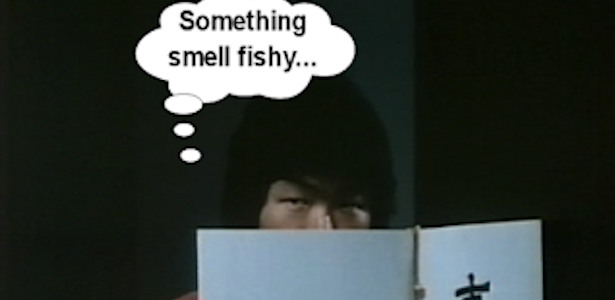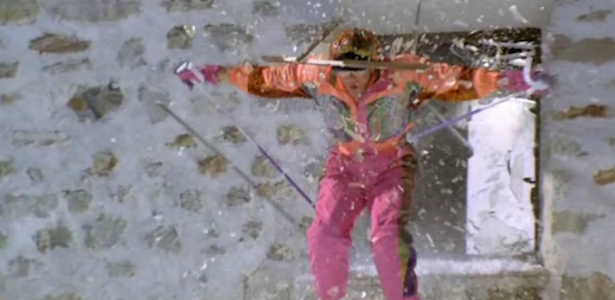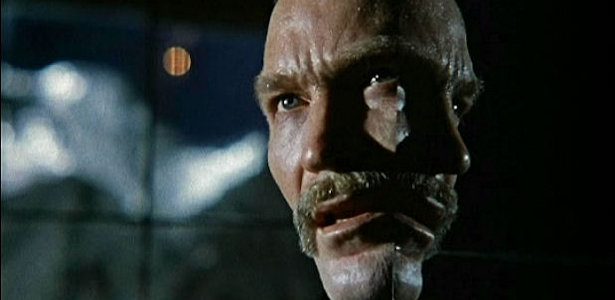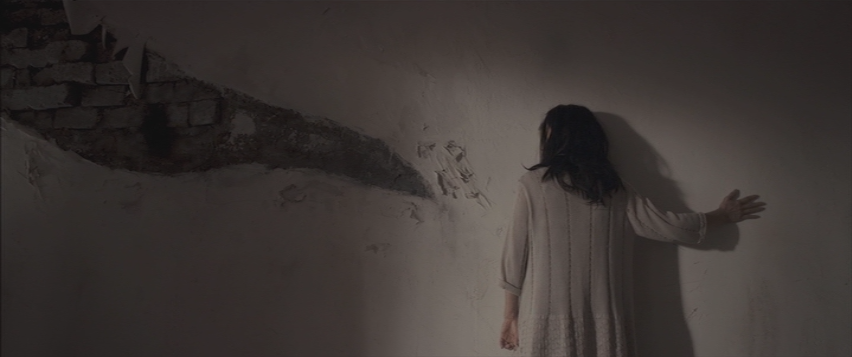Producer Alexey Petrukhin and director Oleg Stepchenko wowed investors with a four minute short they shot detailing the priest Khoma's terrifying night alone in the church with Aleksey Petrukhin essaying the role of the priest (this footage is included in the final film). There was only one small problem. They hadn’t even written the script yet.
According to a behind-the-scenes documentary, screenwriting took place for several months in 2006 with filming scheduled to take place in the sections between autumn 2006 and spring 2007. It was to be a Russia/Ukraine/Czech Republic/U.K. co-production on a budget of $21 million dollars. “How on Earth could they make an effects heavy film with such a pittance?” screams all of Hollywood. It's amazing what you can accomplish when you aren't holding meetings at Spago's every day.
The filmmakers began shooting with the film’s main role – that of cartographer Jonathan Green – uncast; a smart, but incredibly risky move. Promising a “major international star” the hopefuls listed included Vincent Cassel, Ralph Fiennes, Sean Bean, Jason Flemyng, Andy Garcia (!), and Jason Statham. Seriously, try to imagine Jason Statham in a powdered wig and tights. It's an image that will haunt your nightmares. The role eventually went to Flemyng in 2008. Trailers, featuring only the footage shot of the Russian actors, went out in 2008 with the very specific release date of March 12, 2009 listed, three weeks before Gogol’s birthday party. They never showed.
 Later, in November 2009, the filmmakers released more clips of the film and promised VIY in February 2010. They also teased a sequel, VIY 2: CURSED PLACE, to appear shortly thereafter. Ha! Still optimists. Naturally, the new release date disappeared quicker than vodka at a Russian wedding. Insanely, in 2011, the filmmakers decided the film needed massive reshoots and they added a framing story featuring Charles Dance. In April 2012, the new filming was reported in the Russian media as finished and a January 2013 release date was predicted. Can you guess what happened? Yup, they missed it. Long story short, post-production ran over and the film penciled in a new release date in January 2014. Yes, a year later and five years after their initial planned date. I'm sure the filmmakers looked at Aleksei German's 13-years-in-the-making HARD TO BE A GOD (2013) and went, "Hey, we worked nearly double time!"
Later, in November 2009, the filmmakers released more clips of the film and promised VIY in February 2010. They also teased a sequel, VIY 2: CURSED PLACE, to appear shortly thereafter. Ha! Still optimists. Naturally, the new release date disappeared quicker than vodka at a Russian wedding. Insanely, in 2011, the filmmakers decided the film needed massive reshoots and they added a framing story featuring Charles Dance. In April 2012, the new filming was reported in the Russian media as finished and a January 2013 release date was predicted. Can you guess what happened? Yup, they missed it. Long story short, post-production ran over and the film penciled in a new release date in January 2014. Yes, a year later and five years after their initial planned date. I'm sure the filmmakers looked at Aleksei German's 13-years-in-the-making HARD TO BE A GOD (2013) and went, "Hey, we worked nearly double time!" It was all apparently worth the wait as Universal picked up the film for Russian distribution at Cannes in May 2013 and the new VIY broke all of the Russian box office records when it finally debuted. For a film with such a chaotic production history, it is amazing that this actually got to projectors. Furthermore, it is an absolute miracle that it is a coherent and entertaining film.
It was all apparently worth the wait as Universal picked up the film for Russian distribution at Cannes in May 2013 and the new VIY broke all of the Russian box office records when it finally debuted. For a film with such a chaotic production history, it is amazing that this actually got to projectors. Furthermore, it is an absolute miracle that it is a coherent and entertaining film.
An English cartographer, Jonathan Green (Jason Flemyng),
leaves his pregnant betrothed and her irate father (Charles Dance) to create a map of the
Carpathians. Riding in his mechanical, driver-less carriage, he runs across some
monks who have a horrible tale to tell. During a bout of heavy drinking of the local unfiltered moonshine, they tell him of a witch who resides in a nearby village. The two were accompanying a third. The third was a young priest (Petrukhin) who was tasked to stand vigil over the corpse of a beautiful girl in a church, high on a hill over looking the village. They say that his simple vigil turned into a hellish nightmare when the corpse of the beautiful girl turned out to be a witch. Barely able to escape with his life, the priest had never been seen again.
As it turns out there is indeed the body of a beautiful woman in their cursed church. The girl is the daughter of the village leader Sotnik (Yuriy Tsurilo) who secretly pays Green to make a map of the
village by going to the church so he can see over the land. This must be done in secret as access is forbidden by the church. It is actually a ploy to get Green to investigate the church, as Sotnik is suspicious of the "curse" and simply wants to bury his daughter on the one year anniversary of her death.
Born in what is now known as the Ukraine, but at the time was simply part of the Russian Empire, Nikolai Gogol’s 1835 story has been adapted into feature films at least four times prior to this one. Recently we've had the Yugoslavian adaptation, A HOLY PLACE (1990); the Russian adaptation, VEDMA THE POWER OF FEAR (1996); the Korean production EVIL SPIRIT (2008); and previously the Russian classic VIY (1967), upon which this version is based. While A HOLY PLACE and VIY are more or less direct adaptations of the original story, this 2014 version, like VEDMA, has been heavily elaborated on. The only connection with the original story or the 1967
film upon which the script is supposed to be based, is a re-imagining of that film’s climactic sequence. Oddly Stepchenko almost completely recreates the sequence from
the sets, costumes, right down to the look of the actors, though he spruces it up with modern CGI. Here the sequence is used as
part of the set-up for the coming events that have been hewed from whole cloth by Stepchenko and his co-writer Aleksandr Karpov.
 Though it is far and away more lavish looking than something with such a disaster prone
history would imply, it is easy to see where the reshoots came into play.
Literally and metaphorically. In the first half of the film there are some stunning sequences
that were shot in native 3D that contrast sharply with the latter half of the 127
minute film which has been post-converted. The subplot with Charles Dance is clearly tacked on (presumably to add marquee value), and by the end it is clear that many other scenes were awkwardly added. The original press releases stated that this was to be not so much a remake as a re-adaptation of Gogol's original manuscript, though clearly inspiration was taken from the 1967 classic. After the production had wrapped we suddenly saw a whole lot Jason Flemyng falling in mud, water, flour and primordial ooze. While I have to say that Flemyng is not the most versatile actor he acquits himself well here, as he really is simply playing straight man to the village politics and witchcraft.
Though it is far and away more lavish looking than something with such a disaster prone
history would imply, it is easy to see where the reshoots came into play.
Literally and metaphorically. In the first half of the film there are some stunning sequences
that were shot in native 3D that contrast sharply with the latter half of the 127
minute film which has been post-converted. The subplot with Charles Dance is clearly tacked on (presumably to add marquee value), and by the end it is clear that many other scenes were awkwardly added. The original press releases stated that this was to be not so much a remake as a re-adaptation of Gogol's original manuscript, though clearly inspiration was taken from the 1967 classic. After the production had wrapped we suddenly saw a whole lot Jason Flemyng falling in mud, water, flour and primordial ooze. While I have to say that Flemyng is not the most versatile actor he acquits himself well here, as he really is simply playing straight man to the village politics and witchcraft. In spite of lavish production design, excellent cinematography and some high-quality 3D sequences, this version if VIY stumbles over its own shoe-laces with a drawn-out and poorly conceived M. Night Shyamalan inspired story in the second half of the film. This is a
crying shame as there are two absolutely stunning horror sequences in the
first half, one of which is unlike anything that audiences have seen in movies
before. Echoing creatures from Lovecraftian nightmares, Green watches in horror as the villagers in the local tavern transform into indescribably hellish creatures. This sequence blends the use of practical make-up effects with CG in a way that most fans of fantastic cinema only dream of. It is a taste of what THE THING (2011) could have and should have been. If the filmmakers only had the wisdom to scale back their ambitions and simply do the remake that they originally intended with minor elaborations, it may have been something of a modern classic. As it stands, it is longer than it really needs to be and the resolution is unsatisfying.
In spite of lavish production design, excellent cinematography and some high-quality 3D sequences, this version if VIY stumbles over its own shoe-laces with a drawn-out and poorly conceived M. Night Shyamalan inspired story in the second half of the film. This is a
crying shame as there are two absolutely stunning horror sequences in the
first half, one of which is unlike anything that audiences have seen in movies
before. Echoing creatures from Lovecraftian nightmares, Green watches in horror as the villagers in the local tavern transform into indescribably hellish creatures. This sequence blends the use of practical make-up effects with CG in a way that most fans of fantastic cinema only dream of. It is a taste of what THE THING (2011) could have and should have been. If the filmmakers only had the wisdom to scale back their ambitions and simply do the remake that they originally intended with minor elaborations, it may have been something of a modern classic. As it stands, it is longer than it really needs to be and the resolution is unsatisfying.Flush with the success of the first film at the Russian box office, the filmmakers have recommitted to making their sequel, now titled VIY 2: PUTESHESTVIE V KITAY. My Russian is a little rusty, but I'm pretty sure that translates to VIY 2: IT'LL ONLY TAKE US 5 YEARS THIS TIME. Actually, the title translates to VIY 2: JOURNEY TO CHINA. I look forward to its eventual release in 2031.









































































